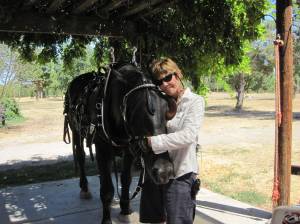For the past few weekends Barn Manager Bonnie MacCurdy has made the trek up North to spend time with Silver at the trainers. Each time she focuses on something different, and this past weekend Silver was introduced to one of Woodside’s indigenous animals: the cyclist. Characterized by bright plumage, they travel in packs throughout our neighborhood, emitting sounds ranging from rapid clicks to sharp bell-like tones. Their seemingly alien appearance has been known to send many a horse into a tailspin.
 With the help of her son Daniel, Bonnie spent an entire day acclimating Silver to the many ways in which cyclists navigate Woodside. Daniel furiously pedaled straight at Silver only to peel off at the last second. He soundlessly approached from behind the carriage, whizzing past the horse without warning. Fast and slow, forwards and backwards, near and far, they made sure Silver was comfortable with it all. By the end of the day the horse would contentedly follow the bike while loose in pasture, walking along the fenceline with Daniel pedaling slowly on the other side.
With the help of her son Daniel, Bonnie spent an entire day acclimating Silver to the many ways in which cyclists navigate Woodside. Daniel furiously pedaled straight at Silver only to peel off at the last second. He soundlessly approached from behind the carriage, whizzing past the horse without warning. Fast and slow, forwards and backwards, near and far, they made sure Silver was comfortable with it all. By the end of the day the horse would contentedly follow the bike while loose in pasture, walking along the fenceline with Daniel pedaling slowly on the other side.
Many have heard or used the term “bombproof” to describe a horse, but its use can be misleading. You may picture a horse standing drowsily at a tie rail, head hanging low, eyes half-closed while fireworks go off just feet away. The thing is, we need our horses to be attentive not comatose. There’s a story about our late Executive Director, Barb Heine, in which she asks hopeful hippotherapy practitioners to identify the most dangerous horse. In front of the group stands a handful of horses, all but one are at attention, heads up, ears pricked as they take in the environment. The last horse is much like the one described before, sleepily ignoring everyone. Which one poses the greatest risk?
When horses show emotion, whether it’s fear or contentment, they communicate with us. If a horse suddenly freezes during a session, raising its head and looking intently at the far end of the sensory trail, we can follow their gaze and see the deer that’ve made a guest appearance. The handler can adjust, soothing the horse or heading to the other side of the arena where the guests are out of sight. Imagine instead that the horse is checked out, dull to their environment. They fail to see the deer until nearly on top of them, and their seemingly sudden appearance causes the horse to startle without warning.

Silver shows a keen interest in his surroundings; simply put, he’s inquisitive. We’re encouraged by his desire to investigate everything and by doing so, to learn at an astounding pace. Like Sunny, at only three years old Silver has the wisdom of a much older horse. With the right training, we’re confident Silver will follow on the same path of his predecessor, becoming not only a therapeutic driving horse, but a member of the NCEFT family.